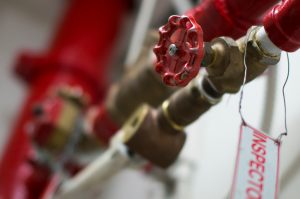
Monthly, quarterly, and yearly sprinkler system inspections are a major part of protecting your business from fire.
Automatic sprinkler systems are extremely important for protecting your business. When they are properly maintained, these systems reduce the risk of a person dying by 50 to 75 percent, according to the Congressional Office of Compliance. It is extremely important for business owners to maintain their sprinkler system in order to avoid malfunctions when they are needed. Your sprinkler system should be inspected at least once per year by a professional sprinkler system inspector. But many companies choose to inspect their fire protection equipment monthly and quarterly to avoid any malfunctions. In addition to regular inspections, your sprinkler system should be inspected whenever it is discharged or when a modification is made to the system or your building. But what is involved in the inspection? Let’s take a look at the sprinkler system inspection checklist.
Monthly Inspections
The first thing you should do during a monthly inspection is to inspection the valves. These valves should be in the following condition:
- In their normal open or closed position
- Properly sealed, locked, or supervised
- Accessible
- Free from external leaks
- Not damaged
- Labeled appropriately.
The next thing to inspect is the gauges. For a wet system, you should make sure all of your gauges are in good condition and that the normal water supply pressure is being maintained. For a dry system, there are several things you should check including:
- The gauge on the supply side of the dry pipe valve for an indication of a normal supply water pressure
- The gauge on the quick-opening device to see if the same pressure is shown as on the dry pipe valve
- The gauges on systems with low air or nitrogen pressure alarms.
Doing a monthly visual inspection will allow you to monitor your system and to call for help if something is not right with your system.
Quarterly Inspections
Your quarterly inspections should include all of the monthly inspection tasks as well as the following:
- Inspection of the water flow alarm and supervisory alarm devices for physical damage
- Test the water flow alarm by opening the test connection on a wet pipe system and the bypass connection on a dry pipe system.
- If your sprinkler system is hydraulic, inspect the hydraulic nameplate to make sure it is attached and visible.
- Make sure your fire department connections are visible and undamaged.
- Make sure the gaskets and valves of the fire department connections are not leaking or damaged.
- Inspect the pressure reducing valves and relief valves.
This inspection is more involved than the monthly inspection and should be done once every three months.
Annual Inspections
Your annual inspection will need to be completed by a professional inspection company in order for it to be valid. It should include all of the monthly and quarterly inspection items as well as the following:
- Inspection of all sprinkler heads, including the piping and fittings
- Inspection of the interior dry pipe valves
- Conduct a main drain water flow test to determine if there has been a change in the conditions of the water supplied through the backflow preventer or pressure reducing valve.
These inspections are a vital part of keeping your business safe from sprinkler system malfunctions and to keeping your building up to code. For more information on Fireline’s Sprinkler System Inspections, call us today!
Sprinkler System Inspections with Fireline
At Fireline, we offer an array of portable fire extinguishers, fire alarms, and sprinkler systems to keep commercial kitchens safe. Fireline offers the highest quality alarm systems to keep your business safe from fires and carbon monoxide poisoning. We also offer fire suppression systems as well to help keep commercial fires controlled should they break out. Our trained technicians will work with you to determine which air sampling smoke detection system is best for your business. We will also help install and maintain the system for your commercial building.
To get started with Fireline today, or for more information on sprinkler systems call us at 1-800-553-3405, or visit our contact page.
Be sure to “Like” and “Follow” the official Fireline page today on Google+, Facebook, Twitter, and LinkedIn.
